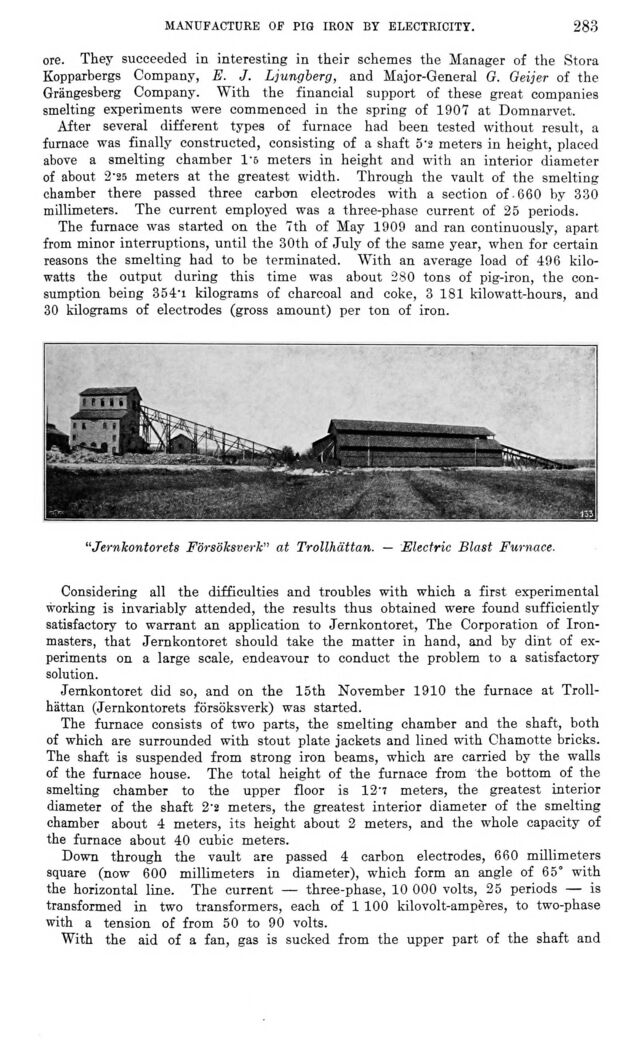
Full resolution (JPEG) - On this page / på denna sida - VI. Mining and Metallurgical Industry. General Survey. By C. Sahlin - 2. Iron and Steel Industry. By J. A. Leffler

<< prev. page << föreg. sida << >> nästa sida >> next page >>
Below is the raw OCR text
from the above scanned image.
Do you see an error? Proofread the page now!
Här nedan syns maskintolkade texten från faksimilbilden ovan.
Ser du något fel? Korrekturläs sidan nu!
This page has never been proofread. / Denna sida har aldrig korrekturlästs.
manufacture of pig iron by electricity.
283
ore. They succeeded in interesting in their schemes the Manager of the Stora
Kopparbergs Company, E. J. Ljungberg, and Major-General G. Geijer of the
Grängesberg Company. With the financial support of these great companies
smelting experiments were commenced in the spring of 1907 at Domnarvet.
After several different types of furnace had been tested without result, a
furnace was finally constructed, consisting of a shaft 5 "2 meters in height, placed
above a smelting chamber 1’6 meters in height and with an interior diameter
of about 2*25 meters at the greatest width. Through the vault of the smelting
chamber there passed three carbon electrodes with a section of . 660 by 330
millimeters. The current employed was a three-phase current of 25 periods.
The furnace was started on the 7th of May 1909 and ran continuously, apart
from minor interruptions, until the 30th of July of the same year, when for certain
reasons the smelting had to be terminated. With an average load of 496
kilowatts the output during this time was about 280 tons of pig-iron, the
consumption being 354’i kilograms of charcoal and coke, 3 181 kilowatt-hours, and
30 kilograms of electrodes (gross amount) per ton of iron.
"Jernkontorets Försöksverk" at Trollhättan. — FAectric Blast Furnace.
Considering all the difficulties and troubles with which a first experimental
working is invariably attended, the results thus obtained were found sufficiently
satisfactory to warrant an application to Jernkontoret, The Corporation of
Ironmasters, that Jernkontoret should take the matter in hand, and by dint of
experiments on a large scale, endeavour to conduct the problem to a satisfactory
solution.
Jernkontoret did so, and on the 15th November 1910 the furnace at
Trollhättan (Jernkontorets försöksverk) was started.
The furnace consists of two parts, the smelting chamber and the shaft, both
of which are surrounded with stout plate jackets and lined with Chamotte bricks.
The shaft is suspended from strong iron beams, which are carried by the walls
of the furnace house. The total height of the furnace from the bottom of the
smelting chamber to the upper floor is 12’7 meters, the greatest interior
diameter of the shaft 2’2 meters, the greatest interior diameter of the smelting
chamber about 4 meters, its height about 2 meters, and the whole capacity of
the furnace about 40 cubic meters.
Down through the vault are passed 4 carbon electrodes, 660 millimeters
square (now 600 millimeters in diameter), which form an angle of 65° with
the horizontal line. The current — three-phase, 10 000 volts, 25 periods — is
transformed in two transformers, each of 1 100 kilovolt-ampères, to two-phase
with a tension of from 50 to 90 volts.
With the aid of a fan, gas is sucked from the upper part of the shaft and
<< prev. page << föreg. sida << >> nästa sida >> next page >>